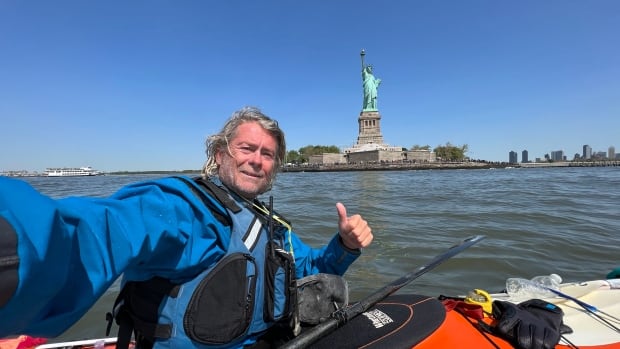
A Canadian kayaker who set out on an 11,000-kilometre solo journey from Nova Scotia, down to the Gulf of Mexico and back up the Atlantic coast last year, has reached the finish line in Halifax exactly 14 months later.
Mark Fuhrmann, 65, started his paddling adventure in Halifax on June 1 last year.
It has taken him down the St. Lawrence River system through Quebec and Ontario, along the Mississippi River and into the Gulf of Mexico, around Florida and back up the Atlantic coast — a route he calls the “Greater Loop.”
“I just had to keep focused the whole time,” Fuhrmann told CBC Radio’s Information Morning Halifax on Tuesday from Ketch Harbour, N.S., just a few hours before his trip came to an end.
“I never knew what was around the bend, but it was a fantastic journey and, you know, even though I would never do it again, I’m so thankful for the lessons learned.”

Fuhrmann is originally from Thunder Bay, Ont., but at 24, he moved to Los Angeles, where he met a Norwegian woman and fell in love.
He then became a “love refugee in Norway” and has stayed there the past 38 years.
Fuhrmann said his tour, which he dubbed “Reverse the Bad,” was about seeking adventure in the form of new relationships and experiences after the death of his wife 10 years ago.
He said the phrase “reverse the bad” is meant to encourage people to let go of what’s weighing them down, and instead use that energy to lift up their neighbours and take care of the environment.
“I found that waking up in my tent, listening to the nature around me, the birds awake, the lapping of the water against the shoreline — all these small things just really affected my journey and understanding about myself,” he said.

Fuhrmann said before this trip, he didn’t understand what “nature people” were talking about.
“But after living in nature for 12 months, I understand that it’s pure and it’s innate within us and we need to escape into nature to find part of ourselves,” he said.
Fuhrmann said he also used the trip to raise money for two organizations: Doctors Without Borders and Captains Without Borders, a non-profit that supports aspiring seafarers.
Challenges of journey
He said one of the most challenging parts of the trip was finding a place to sleep every night. He said he tented 90 per cent of the time, but he also “stealth camped” in cabins and boats that had been left open.
“At first, I felt very embarrassed because I’m 65 and I’m in a place where maybe I shouldn’t be. But I thought, if it was me, what would I do? If it was my cabin, what would I do? And when I went in, I left it better than when I came,” he said.
“Sometimes I even took a Coca-Cola or something and I left $5 or $10 and I wrote a note and said, ‘Hi, my name is Mark. I’ve been here. I’m on the reverse the bad journey.’ I just hope people smiled when they saw it.”

Fuhrmann said he would stealth camp in Canada, but he was hesitant to do the same in the United States.
“The only encounter I had was in America where a lady had a revolver in her housecoat and she was ready to use it. But other than that 99.9 per cent of the people I’ve met on the journey have been utterly fantastic,” he said.
Fuhrmann said he continued to stealth camp as he made his way up to Nova Scotia. He said in the last 15 days, he’s stayed in lobster boats in Clarks Harbour, Ingomar and Jones Harbour.
“If it was open, I went in and put my sleeping bag on a mattress and that’s the way I’ve lived, you know? It’s just unbelievable,” he said.

But Monday night, his last night before reaching Halifax, he had a different experience.
He walked up to a property in Ketch Harbour, explained his situation to the woman who opened the door and asked if he could camp on her lawn.
Instead, the woman, named Erica, offered him her spare room.
“She opened her home. We brought in pizza and a neighbour, Andrew, came and [it was] just a beautiful, beautiful last night,” he said.
“And to meet wonderful people of Nova Scotia, and I’ve met such fantastic people along my route, I’m so, I’m so enthused.”

Fuhrmann landed at the Atlantic School of Theology in Halifax around 2 p.m. Tuesday.
“It’s been probably one of the most extreme things I’ve ever done in my life. When I started out, I didn’t know it would be this difficult,” he said.
“And actually, I’m really looking forward to ending it and getting back to my family, which I haven’t seen for 14 months.”
Fuhrmann has been tracking his journey online. You can see his route here.
Information Morning – NS10:56Kayaker lands in Halifax after 11,000 km journey on the waterways of North America
In June 2022, Mark Fuhrmann embarked on a kayak adventure that took him from Eastern Passage to Chicago, down the Mississippi, to the Gulf of Mexico, and by New York. He tells us about his journey as it comes to an end in Halifax.